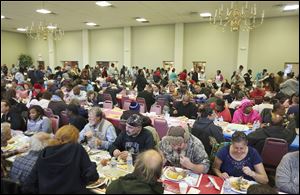
EDITORIAL
Invisible poverty holds us back
11/20/2017
A luncheon for the homeless and under-housed Thursday, November 16 at the Holy Trinity Greek Orthodox Church Banquet Hall. Poverty is not limited to a few neighborhoods that the rest of the city can ignore.
When The Blade revealed in July that Toledo Public Schools has more homeless students than any other school district in Ohio, many in the community were shocked.
People asked Family House Executive Director Renee Palacios how this could be so. They never see homeless children in Toledo, they would tell her.
Click here to view more Blade editorials
“I would ask them, ‘What does a homeless kid look like?’ They look just like your kids; they have wide eyes and two feet and they love pizza.”
Homelessness — particularly with families — does not often look like the stereotypical street person sleeping over a grate on the sidewalk.
More than 27,000 TPS students are homeless. Their families are part of an increasing homelessness problem in a city where more than a quarter of people live at or below the poverty line.
They often shuttle from relative to relative, staying with family members temporarily. It’s a transient and insecure lifestyle that can damage a child’s development and performance in school. It does not look like homelessness as most people understand it.
“Homelessness is more than a lack of home,” Ms. Palacios told an audience at a recent fund-raiser for the Homeless Services Partnership — the five-year-old collaborative effort by four Toledo-based agencies that deal with homeless families in the region.
As individual agencies, Aurora Project, Bethany House, La Posada, and Family House do amazing work to help some of the most vulnerable families in northwest Ohio. As a cooperative group of four agencies, they have been able to multiply the effect of their work.
As a collaborative, the group has brought in $180,000 in grants that would not have otherwise been available. They have been able to share staff and software, streamlining their operations to do more with an ever-shrinking pool of funding.
Toledo’s homelessness and poverty are two threads in a tangle of problems that threaten the city’s revival. A lack of middle-class job opportunities, a lack of affordable housing, food insecurity, and spiraling rates of addiction all contribute to a growing number of Toledo families that live just one missed paycheck or serious illness away from catastrophe.
The Homeless Service Partnership is looking to build on its success, hoping to find partnerships with similar agencies. Other social service agencies in the region should copy their model. The myriad after-school program providers, for instance, could organize and cooperate in ways that maximize their efficiency in the same ways.
Poverty is not limited to a few neighborhoods that the rest of the city can ignore. It threatens to stall Toledo’s renaissance. Rooting it out is going to demand the kind of collaborative efforts pioneered by these agencies that have done more cooperatively than they could accomplish on their own.